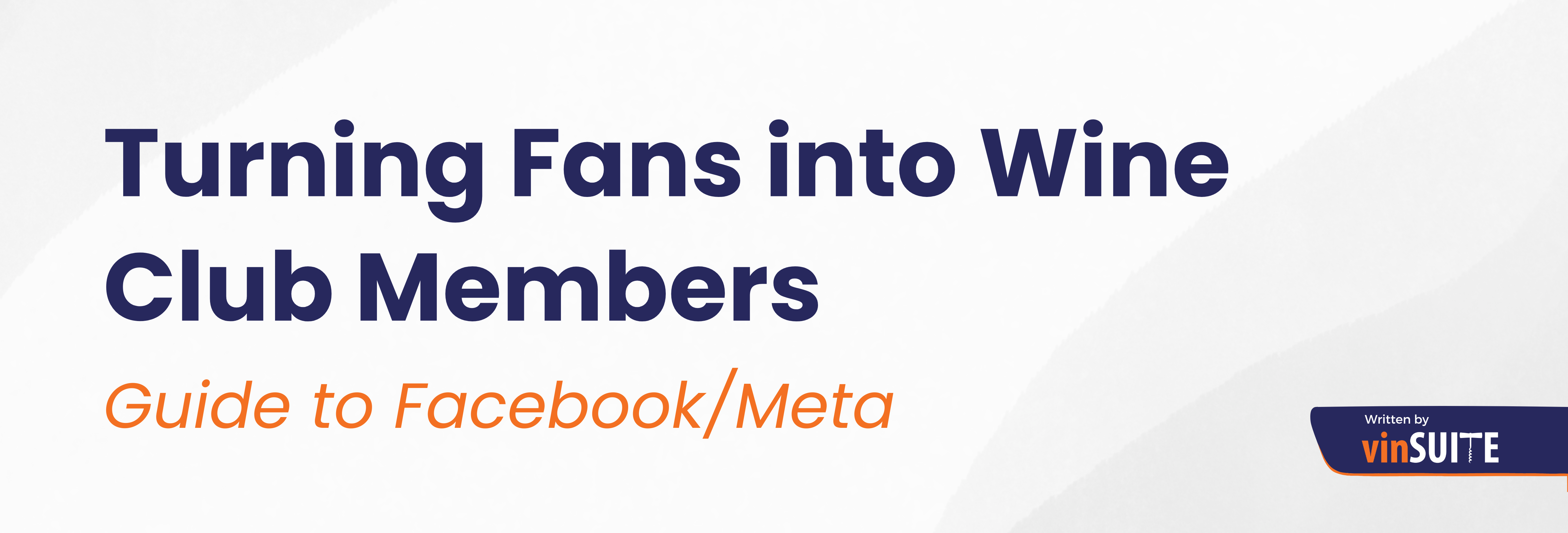
Facebook has been around for two decades, and while newer platforms like TikTok and Instagram steal the spotlight, Facebook is still one of the most powerful tools for wine club growth, especially when paired with Meta’s advanced targeting and advertising capabilities.
With 72% of wine consumers aged 35–65 actively using Facebook, this platform isn’t just a place to post updates—it’s where wineries can build relationships, create engaged communities, and drive conversions.
But here’s the issue: Most wineries aren’t using Facebook to its full potential.
They post a bottle shot here, a vineyard view there, and maybe a tasting room event. But if you’re not actively engaging with your audience, creating valuable content, and leveraging Meta’s advertising tools, you’re missing out on a major acquisition channel for your wine club.
Let’s break down how to turn Facebook into a wine club membership machine—without wasting time on content that doesn’t convert.
Step 1: Use Facebook as a Relationship Builder, Not Just a Newsfeed
Facebook is not just a place to post updates—it’s a place to connect.
Unlike Instagram, where quick visuals dominate, Facebook thrives on storytelling, conversations, and engagement. The more your audience interacts with your content, the more Facebook’s algorithm pushes it to others likely to engage.
How to make Facebook work for your winery:
| Strategy | Why It Works |
|---|---|
| Post with a purpose | Every post should educate, entertain, or invite engagement, not just show a bottle of wine. |
| Engage in the comments | Facebook rewards active brands. Respond to every comment to boost visibility and connection. |
| Encourage UGC | Ask members to share club experiences, pairings, or winery visits. |
| Share behind-the-scenes | Longer-form stories like harvest updates or winemaker spotlights perform well on Facebook. |
Pro Tip: Facebook prioritizes posts with active conversations. Posts with questions, polls, or discussions get more reach than static updates.
Step 2: Leverage Facebook Groups for Wine Club Community Building
Want to keep current members engaged and make future members feel like they’re missing out? Facebook Groups might be your secret weapon.
Unlike a business page, Groups offer exclusivity and foster deeper, more organic interaction.
Group Ideas for Wineries:
| Group Type | Description |
|---|---|
| Members-Only Wine Club Group | Offer early access to releases, special behind-the-scenes content, and winemaker interaction. |
| Public “Wine Lovers” Group | Foster wine education, pairing discussions, and community-building, with soft club promotion. |
| Community-Focused Engagement | Host virtual tastings, post wine challenges, and start discussions to keep energy high. |
Key Takeaway: Groups generate higher organic reach than regular posts and deepen relationships with both current and potential members.
Step 3: Facebook Events—More Than Just RSVPs
Most wineries host events. But are you using Facebook Events strategically?
Creating an event not only alerts your followers, but it also places your winery in front of local wine lovers who don’t follow you yet.
How to Make Facebook Events Work for You:
| Tactic | Why It Matters |
|---|---|
| Promote virtual & in-person | Use Events for tastings, vineyard dinners, live streams, and more. |
| Encourage RSVPs | The more people click “Interested” or “Going,” the more Facebook spreads the event organically. |
| Use event discussion area | Post teaser videos, behind-the-scenes content, or perks to build excitement before the event. |
| Retarget event attendees | Run ads after the event to turn interest into membership. |
Pro Tip: Even if someone doesn’t attend, RSVP data creates a retargeting audience full of warm leads.
Step 4: Meta Ads—The Best Paid Strategy for Wine Club Growth
Organic content is great, but Meta Ads are where scalable wine club growth happens. With powerful audience targeting and retargeting tools, Facebook Ads give you direct access to wine lovers ready to engage.
What Makes Facebook Ads So Effective?
| Feature | Benefit |
|---|---|
| Audience targeting | Reach people based on interests, behavior, and demographics—like wine lovers aged 35–65. |
| Website retargeting | Show ads to visitors who viewed your wine club page but didn’t join. |
| Lookalike audiences | Find new leads who resemble your most valuable members. |
Ad Types That Work Well for Wineries:
| Ad Type | Purpose |
|---|---|
| Lead generation ads | Capture emails from wine-curious visitors and nurture them with email marketing. |
| Retargeting ads | Remind site visitors of wine club perks and limited-time offers. |
| Testimonial ads | Feature real members sharing their wine club experiences for added authenticity. |
| Limited-time offers | Create urgency with seasonal discounts, new release bundles, or first-month-free promos. |
Key Takeaway: Facebook Ads aren’t just for selling bottles—they guide future members through the wine club decision journey.
Final Thoughts: Why Facebook/Meta Still Matters for Wine Clubs
Despite new platforms drawing attention, Facebook and Meta remain essential tools for wine club marketing, especially when used intentionally.
Wineries that succeed on Facebook:
- Use it as a relationship builder, not just a place to post.
- Leverage Facebook Groups to create exclusivity and deepen engagement.
- Host strategic Events to drive awareness, attendance, and follow-up conversions.
- Invest in Meta Ads to reach the right people at the right stage of the journey.
If your winery is posting sporadically or without a strategy, it’s time to rethink how you use Facebook. The opportunity isn’t gone—you just need to unlock it with the right approach.
Want More Wine Club Growth Strategies?
This blog expands on concepts covered in our Wine Club Scorecard.
Take our 22-question Wine Club Scorecard and receive a personalized 20+ page PDF report with actionable insights to grow your memberships, boost retention, and increase revenue.


